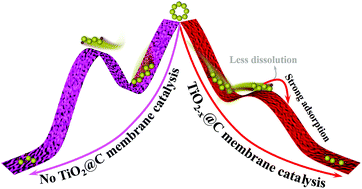A hierarchically porous TiO2@C membrane with oxygen vacancies: a novel platform for enhancing the catalytic conversion of polysulfides†
Abstract
In cases involving high levels of sulfur loading or high levels of current discharge, constructing sulfur composite cathodes via traditional coating preparation processes is an unsuitable way to overcome intractable problems relating to cathodes for use in lithium–sulfur batteries, such as poor conductivity, severe volume expansion, and the detrimental shuttle effect. Herein, a novel three-dimensional self-supported TiO2@C membrane with hierarchical interlinked porosity and oxygen vacancies was prepared via a phase-inversion method to act as a sulfur host. The procured TiO2−x@C membrane facilitates the infiltration of electrolyte, provides fast lithium-ion and electron transport channels and abundant sulfur loading sites, and shows superb structural buffering against the large volume changes during the conversion process between sulfur and lithium sulfide. More importantly, the introduction of oxygen vacancies not only enhances the conductivity of the original TiO2, but it also improves the corresponding adsorption abilities toward polysulfides and the subsequent transformation dynamics. Therefore, the TiO2−x@C membrane can significantly inhibit the polysulfide shuttle effect through polar chemisorption and conversion catalysis. Based on the above superiorities, the TiO2−x@C/S membrane electrode exhibits an impressive lifespan of more than 500 cycles at 2 C with a prominent ultimate specific discharge capacity of 715.2 mA h g−1.



 Please wait while we load your content...
Please wait while we load your content...